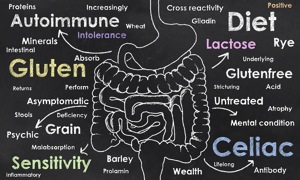
Congratulations, you've gone gluten free to improve your health! Perhaps you have celiac disease, or non-celiac gluten sensitivity, both of which require avoidance of gluten for optimal health. You know to avoid wheat, barley, rye, triticale, einkorn, farro, kamut, spelt, farina, emmer, durum, and semolina, plus most oats because they are commonly cross-contaminated with gluten grains in the field or factory. That pretty much sums it up, right?
Well, not quite. Gluten can actually reside as a hidden component in many common food ingredients, which can make food shopping, restaurants, travel, and potlucks a risky business. In this article, we'll offer some guidelines for successfully navigating this tricky terrain.
Navigating Food Labels
Manufacturers are not presently required to identify gluten as an ingredient on labels. Just because a product doesn't list a gluten grain, doesn't mean it's gluten-free.
Your greatest tool in determining what is safe to eat is to read food labels, and become familiar with stealthy ingredients that may include gluten. Have you ever seen an ingredient that you can't identify? If so, it's best to avoid it. Here is a (non-exhaustive) list of some common ingredients that can contain gluten:
- Malt, and barley malt
- Food starch and modified starch
- Dextrin and maltodextrin — sourced from corn or wheat
- HPP = Hydrolyzed Plant Protein
- HVP = Hydrolyzed Vegetable Protein
- TVP = Texturized Vegetable Protein
- "Natural flavor"
- "Spices"
- "Artificial flavor"
- Brewer's yeast
- Gelatinized and pregelatinized starch
- Brown rice syrup
Pre-packaged foods can add a challenge as well. Below are some common foods that may have gluten in them. Look for a certified GF label if you aren't sure; otherwise, pass it up.
- Soy sauce (a good replacement is coconut aminos, or wheat-free tamari — 100% soy)
- Many salad dressings use gluten thickener
- Gravies, sauces, marinades
- Fish sauce (common in Thai restaurants)
- Canned and boxed soups
- Soup mix
- Bouillon
- Licorice candy
- Instant coffee
- Coffee substitutes
- Condiments
- Puddings and pie fillings
- Processed meats (gluten is used as a binder in cold cuts, hot dogs, sausages, and some specialty/reformed meats)
- Many reduced-fat and ready-made foods have binder starches sourced from wheat
- Ice cream — look out for added gluten (cookie dough, anyone?) and beware of scoop cross – contamination where ice cream is served
- Mashed potatoes
- Imitation crab
- Some wasabi
- Vegan meat substitutes
- Chips (factory cross-contamination)
- Beer
- White sauce (made from a wheat flour roux)
- Worcestershire
- Communion wafer (ask your church about bringing your own GF version)
- All Chinese condiments contain wheat, including soy, oyster, hoisin, and bean sauces
- Some spice companies use glutenous fillers; use only pure, high-quality herbs and spices with no fillers
The Restaurant Dilemma
Restaurants can pose their own challenges. Here are some things to look out for:
- Fried food; those delectable fries may have been cooked in the same oil that fried the onion rings doused in wheat batter
- Vegetables may have been par-boiled in the pasta water
- At Asian restaurants, you may ask for GF but the busy chef may not be looking at the ingredients on the hoisin or fish sauce; ask for no sauce if uncertain.
- GF foods may be prepared on the same surfaces or with the same utensils that glutenous foods touch.
If you are uncertain at a restaurant, talk to the chef directly. If you aren't happy with the answer, don't eat there. Many restaurants are becoming aware of the need for truly GF foods, but it's always good to make sure they are careful about food prep. Ask friends, and ask local online GF groups about recommended eateries.
Gluten Free Shopping: When In Doubt, Go Without!
When you are new to eating GF, restaurants and grocery shopping can be daunting, but the more you do it, the better you'll get at determining what goes in your belly. If you aren't sure, don't eat it. Ask questions, read ingredient labels; just because those noodles say, "Rice" on the front, that doesn't mean they don't have a gluten grain added in. "Wheat-free" doesn't necessarily mean gluten free. Lastly, always check product labels for warnings that state a food is produced in a factory that also makes gluten-based products; if it is, cross-contamination could be an issue.
The more you do it, the more natural it becomes, and soon you will be navigating your gluten-free life with ease.
Gluten cross-reactivity with non-gluten foods
Non-gluten grain options include: rice, corn, amaranth, millet, quinoa, sorghum, teff, and buckwheat (not actually in the wheat family). However, these grains can cross-react with gluten in some people. This means their body recognizes them as gluten and responds with a reaction. An elimination/provocation diet or food sensitivity test can let you know which grains are safe to eat. Dairy is another food that commonly cross-reacts with gluten, as is coffee. If your gluten-free diet is not helping you feel better you may need to consider cross-reactive foods.
Diet soda, artificially-sweetened foods
Though it does not actually contain gluten, the artificial sweetener aspartame is recognized as a serious offender for many with gluten intolerance or celiac disease. Since aspartame often triggers similar allergic symptoms, including severe stomach pain and bloating, avoiding it can spare you the pain and suffering.



Latest from the Blog
The Death of Red Dye #3
January 15, 2025What Is Red Dye No. 3? Red Dye No. 3, or Erythrosine, is a synthetic food color derived from coal tar. It was first approved by the FDA in the 1950s and quickly became one of the most popular artificial colors in food and cosmetics. Red Dye No. 3 was used in everything from candies, […] Read more
Latest from the Blog
Do You Know What Is In Your Protein Powder?
What’s Really in Your Protein Powder? Understanding the Risks Protein powders are a staple in many health-conscious diets, from athletes seeking muscle recovery to those simply aiming to boost their daily protein intake. With a wide variety of options available, choosing the right one can feel overwhelming. However, recent findings have raised concerns about what’s […] Read more